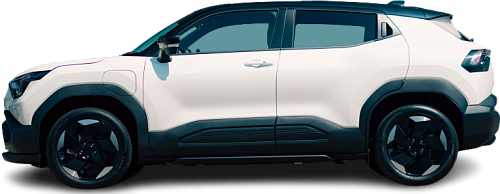Global EV Comparison: Suzuki e Vitara 49 kWh FWD vs Nissan Leaf 52 kWh
Struggling to Decide? Let AI Help!
Your AI Summary Is Ready!
General Info
The Suzuki e Vitara 49 kWh FWD (2025-…) is currently produced, it has a starting price of €31995. Although the Nissan Leaf 52 kWh (2025-…) has been announced, it is not yet in production and will not be available for sale in Europe.
The two vehicles share the same body style: SUV.
| Property | Suzuki e Vitara 49 kWh FWD | Nissan Leaf 52 kWh |
|---|---|---|
| Years of Production | 2025-… | 2025-… |
| Current Status | Produced | Announced |
| Country of Manufacture | India | Japan, UK, USA |
| Body Style | SUV | SUV |
| Market Availability | EU | EU, USA |
| Price Europe (New) | €31995 | - Price Europe (New) |
| GCC Score | 5.5 | 5.6 |
Range and Efficiency
The Nissan Leaf 52 kWh (2025-…) boasts a greater real-world range, a larger battery, and superior energy efficiency compared to the Suzuki e Vitara 49 kWh FWD (2025-…).
| Property | Suzuki e Vitara 49 kWh FWD | Nissan Leaf 52 kWh |
|---|---|---|
| Range (EPA) | - Range (EPA) | 402 km |
| Range (WLTP) | 344 km | - Range (WLTP) |
| Range (GCC) | 292 km | 382 km |
| Battery Capacity (Nominal) | 48.8 kWh | 52 kWh |
| Battery Capacity (Usable) | 47.8 kWh | 49.4 kWh |
| Efficiency per 100 km | 16.4 kWh/100 km | 12.9 kWh/100 km |
| Efficiency per kWh | 6.11 km/kWh | 7.73 km/kWh |
| Range and Efficiency Score | 6 | 8.1 |
Charging
Both vehicles utilize a standard 400-volt architecture.
The Nissan Leaf 52 kWh (2025-…) offers faster charging speeds at DC stations, reaching up to 150 kW, while the Suzuki e Vitara 49 kWh FWD (2025-…) maxes out at 55 kW.
The Suzuki e Vitara 49 kWh FWD (2025-…) features a more powerful on-board charger, supporting a maximum AC charging power of 11 kW, whereas the Nissan Leaf 52 kWh (2025-…) is limited to 7.2 kW.
| Property | Suzuki e Vitara 49 kWh FWD | Nissan Leaf 52 kWh |
|---|---|---|
| Max Charging Power (AC) | 11 kW | 7.2 kW |
| Max Charging Power (DC) | 55 kW | 150 kW |
| Architecture | 400 V | 400 V |
| Charge Port | CCS Type 2 | CCS Type 2 |
| Charging Score | 5.4 | 4.6 |
Performance
Both vehicles are front-wheel drive.
The Nissan Leaf 52 kWh (2025-…) boasts greater motor power and accelerates faster from 0 to 100 km/h.
| Property | Suzuki e Vitara 49 kWh FWD | Nissan Leaf 52 kWh |
|---|---|---|
| Drive Type | FWD | FWD |
| Motor Type | PMSM | PMSM |
| Motor Power (kW) | 106 kW | 130 kW |
| Motor Power (hp) | 142 hp | 174 hp |
| Motor Torque | 189 Nm | 345 Nm |
| 0-100 km/h | 9.6 s | 7.5 s |
| Top Speed | 150 km/h | 144 km/h |
| Performance Score | 2.5 | 3.3 |
Dimensions
The Nissan Leaf 52 kWh (2025-…) has a longer body, while the Suzuki e Vitara 49 kWh FWD (2025-…) stands taller, offering a more elevated ride. Their widths are almost identical, so both offer a similar amount of shoulder room.
Both models have similar wheelbase lengths.
| Property | Suzuki e Vitara 49 kWh FWD | Nissan Leaf 52 kWh |
|---|---|---|
| Length | 4275 mm | 4405 mm |
| Width (with Mirrors) | 2065 mm | 2099 mm |
| Width (w/o Mirrors) | 1800 mm | 1810 mm |
| Height | 1635 mm | 1557 mm |
| Wheelbase | 2700 mm | 2690 mm |
Cargo and Towing
The Nissan Leaf 52 kWh (2025-…) provides more cargo capacity, featuring both a larger trunk and more space with the rear seats folded.
Neither car is equipped with a frunk (front trunk).
Neither vehicle is officially rated for towing in in the EU.
| Property | Suzuki e Vitara 49 kWh FWD | Nissan Leaf 52 kWh |
|---|---|---|
| Number of Seats | 5 | 5 |
| Curb Weight | 1775 kg | 1794 kg |
| Cargo Volume (Trunk) | 238 l | 565 l |
| Cargo Volume (Max) | 562 l | 1573 l |
| Cargo Volume (Frunk) | - Cargo Volume (Frunk) | - Cargo Volume (Frunk) |
| Cargo and Towing Score | 5.8 | 5.8 |




